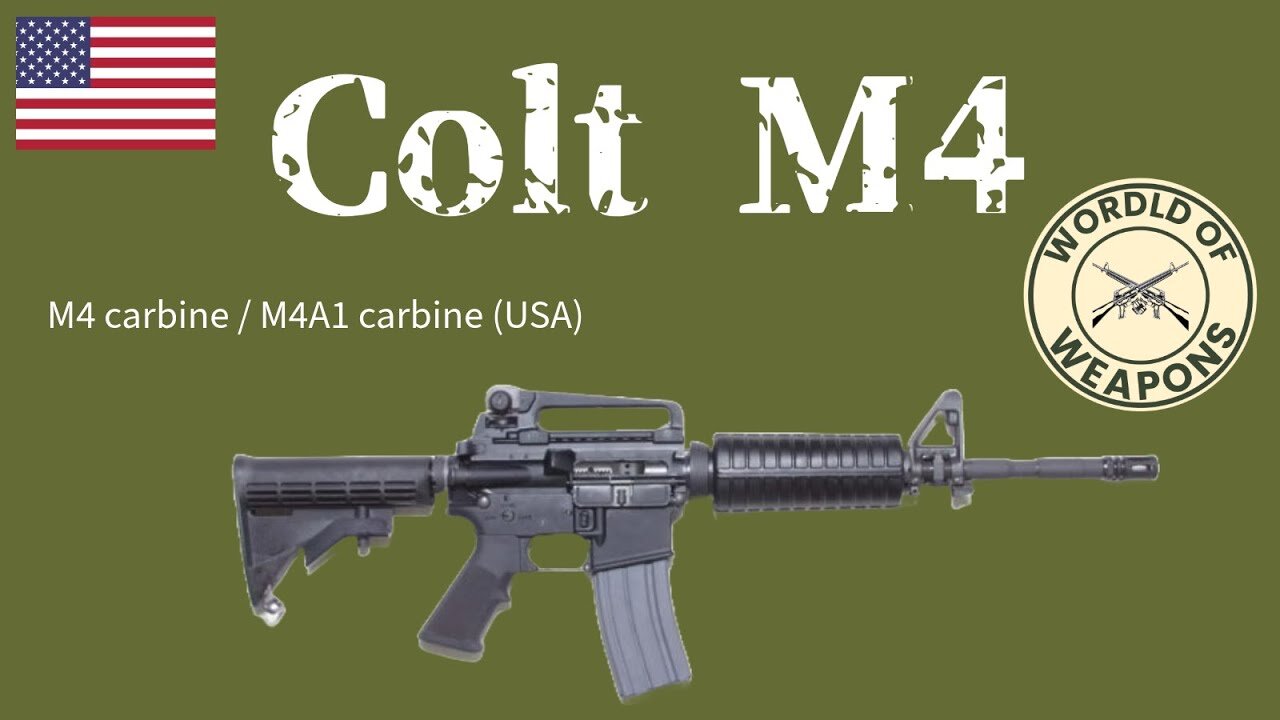Premium Only Content

M4 / M4A1 🇺🇸 The war baton of the American army
M4 / M4A1 Carbine
The M4 carbine was developed by the famous Colt company on request from the US Armed forces, as a shortened version of a then-new M16A2 rifle. It was intended as a personal defense weapon for non-infantry personnel, to replace ineffective handguns and obsolete submachine guns in this role. Colt received an initial development contract in 1984, and by 1986 first XM4 carbine prototypes were delivered to US Army for initial tests. It took several more years to finalize and approve the design, and in 1994 US DoD officially adopted M4 and M4A1 carbines for service.
Until 2009, Colt company possessed intellectual property rights on the M4 Carbine TDP (technical data package) and was the sole supplier of M4 carbines to the US Military. Other companies produced similar clones as well, but those were sold either to civilian markets (in semi-automatic only versions) or foreign clients. In 2013 FN Manufacturing Inc, a US-based subsidiary of the famous Belgian company FN Herstal won a significant contract to deliver M4A1 carbines to US Army, and now it appears to be a major supplier of carbines to US DoD. Colt still makes select-fire M4 and M4A1 carbines too, and offers semi-automatic, civilian legal versions of the M4 carbine with 16-inch barrels.
Early on US SOCOM selected the M4 carbine as a potential primary individual weapon for its operators, for its handiness and lighter weight. Subsequently, it developed the so-called SOPMOD M4 kit which includes a RIS forend and several ancillaries such as sights, forward grips, sound suppressors, etc.
Initial combat experiences in Afghanistan and Iraq resulted in several desired updates, addressing the reliability and durability of the carbine. As a result, the M4A1 carbine and the M4 carbine are now fitted with a heavier barrel, which better withstands protracted and intense firing. Despite the shorter effective range and decreased lethality, as compared to the M16A2 or M16A4 rifle, by 2015 the M4 / M4A1 carbine became the primary fighting rifle for US Army and US Marine Corps Infantry units.
As of early 2022, US Army plans to replace M4 carbines in the front-line infantry units with a new, much more potent weapon which is being developed under the NGSW program, but so far this program brought no definite results. If the NGSW program succeeds, the M4 carbine again will be relegated to its original role as the Personal Defense Weapon for non-infantry units.
The M4 carbine is mechanically similar to the M16A4 rifle, except for the following major updates. It features a shorter, 14.5-inch barrel, and a telescoped shoulder stock. Internally it features a different bolt carrier buffer, shorter gas system, and an altered feed ramp cut in the barrel extension and the receiver, to ensure reliable feeding. Almost all M4 carbines, except for the earliest production run, feature so-called “flat-top” receivers with integrated Picatinny rail, which replaced the M16A2-style carrying handle. Most current production M4 carbines also feature RIS forends with additional rails. The M4 carbine can deliver semi-automatic fire and 3-round bursts, and its safety/fire selector lever is appropriately marked “Safe – Semi – Burst”. The M4A1 carbine does not have a burst limiting mechanism in its trigger unit, and its selector is marked “Safe – Semi-Auto”. All other properties of the M4 and M4A1 are similar.
As a primary infantry weapon, the M4 carbine can be fitted with a knife-bayonet, an underbarrel grenade launcher such as M203 or M320, a sound suppressor, and a host of other accessories such as tactical flashlights, laser designations, and various day and night sights. For close combat, its standard upper receiver can be replaced with the Mk.18 with an even shorter 10.3-inch barrel. Another recent upgrade for USSOCOM M4A1 carbines in the 5.56mm SURG (Suppressed Upper Receiver Group), built by SIG-Sauer and based on their SIG MCX rifle.
-
 3:20
3:20
World Of Weapons
1 year agoChiappa Rhino 🇮🇹 Italian strength, power and softness at the same time
106 -
![Batman Arkham Knight [4K + Mods] Hardest Difficulty ⋆ Western Re-tread](https://1a-1791.com/video/fww1/ca/s8/1/7/9/T/V/79TVy.0kob-small-Batman-Arkham-Knight-4K-Mod.jpg) 3:50:55
3:50:55
FusedAegisTV
5 hours agoBatman Arkham Knight [4K + Mods] Hardest Difficulty ⋆ Western Re-tread
40.3K3 -
 2:25:09
2:25:09
Tundra Tactical
5 hours ago $3.15 earned🚨🔫Tundra Nation Live Rips Apart Media Lies on Short Barreled Rifles & Suppressors 🎇🧨
81.2K1 -
 2:47:06
2:47:06
Barry Cunningham
7 hours agoPRESIDENT TRUMP PROTECTED AMERICA AND NOW THE WORLD AND THAT DEMOCRATS KNOW!
51.9K48 -
 LIVE
LIVE
Joker Effect
1 hour agoSoundboard Lord / Midnight In The Mountains talk about Gaming on the Rumble platform. Is it good?
564 watching -
 LIVE
LIVE
Cewpins
1 hour agoLet's Get HIGH!🔥Rumble Creator Sesh at Midnight! 💨420🍃Switch 2 !giveaway
129 watching -
 LIVE
LIVE
Mossy
9 hours ago🔥MODDED MAYHEM🔥ALL THE MODS 9 RUMBLECRAFT GRIND🔥420 SESH🔥#RUMBLETAKEOVER🔥
49 watching -
 21:53
21:53
Stephen Gardner
6 hours ago🔥What EVERYONE missed about Trump bombing Iran!
68.9K382 -
 LIVE
LIVE
CharleyHornsePlays Rage Gaming
2 hours agoCharleyHornsePlays | REMATCH with the boys | Get fully soccered on
13 watching -
 3:18:19
3:18:19
Shoriantrax
4 hours agoGOON WIPED. BAGS MAXED. | Tarkov Raid With ShoriAntrax
26.7K